Sometimes, it can seem like creative endeavors flow effortlessly for others, leading us to compare the challenges we face in our own creative processes. While we each possess our own strengths and weaknesses, the creative muse is a demanding force for everyone. Similar to the illusion of the Wizard of Oz and the man behind the curtain, the world of art-making often differs from the polished images we encounter online and out in the world. Here, I will pull back that curtain and unveil the true reality behind one painting to show you that it’s far from the constant sunshine and butterflies that some may imagine.
The Painting: I am Earth and My Orbit is Clumsy
July 26, 2021 – The collection.
I don’t always start with a narrative or clear idea. In many cases, I just pull out everything I can and start grouping them by color, or shape, or theme. This pile of objects began with white, grey and red but slowly turned into a somewhat nautical theme. I wasn’t super psyched about it yet so I took a pic and then put the stuff away.

The initial stuff.
This is me when I have my existential crisis when I’m not sure what to paint. Believe it or not, this is the hardest part. There’s a very real weight to searching for an idea. There’s always the lingering fear that I’ve already used up all my good ideas and that I’ll never have a cool idea again. This is also when I wish I had an endless well of creative ideas to pull from and I hate all my stuff and I need a nap.

The crushing weight of trying to find an idea.
November 29th, 2021 – The Online Argument and The Post It
I don’t recommend wasting your time arguing with people online. I don’t always take my own advice. I began a conversation with a flat-earther with a genuine desire to understand how they could reconcile both having atelier training (where we trust the physics of light and form) with the conspiracy theory which makes no sense with the physics that we scientifically base all of our current technology on. After this discussion ended (going nowhere, obviously) with me all riled up, I was so frustrated that I needed to make a painting about it. Catharsis anyone?
I quickly sketched this on a post it and yes, this is the extent of my “sketches”.
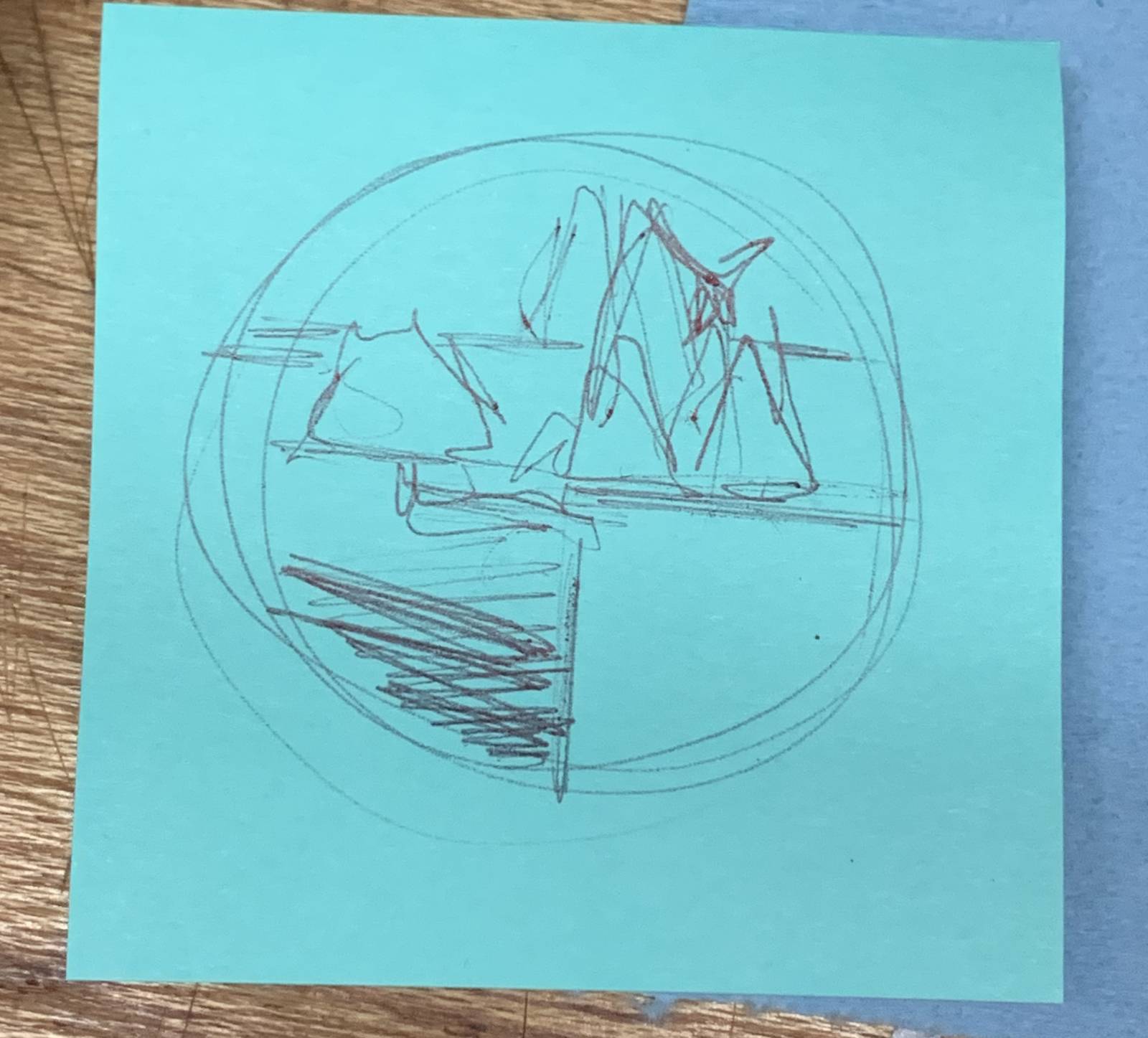
The post it sketch
When I got back in the studio, I felt that I needed to use a nautical theme with the boat about to fall off a book on the end of the still life. Sailors were likely some of the first to develop the need to understand our planets physicality so it felt fitting for this topic. Out came those nautical themed items from 5 months ago. For the next week, I played with the objects and design. After about 7 days the set up was pretty much complete. I’ll be honest, this was faster than usual because of the previous time I had pulled together items and the clear vision of the boat and book for the flat surface.
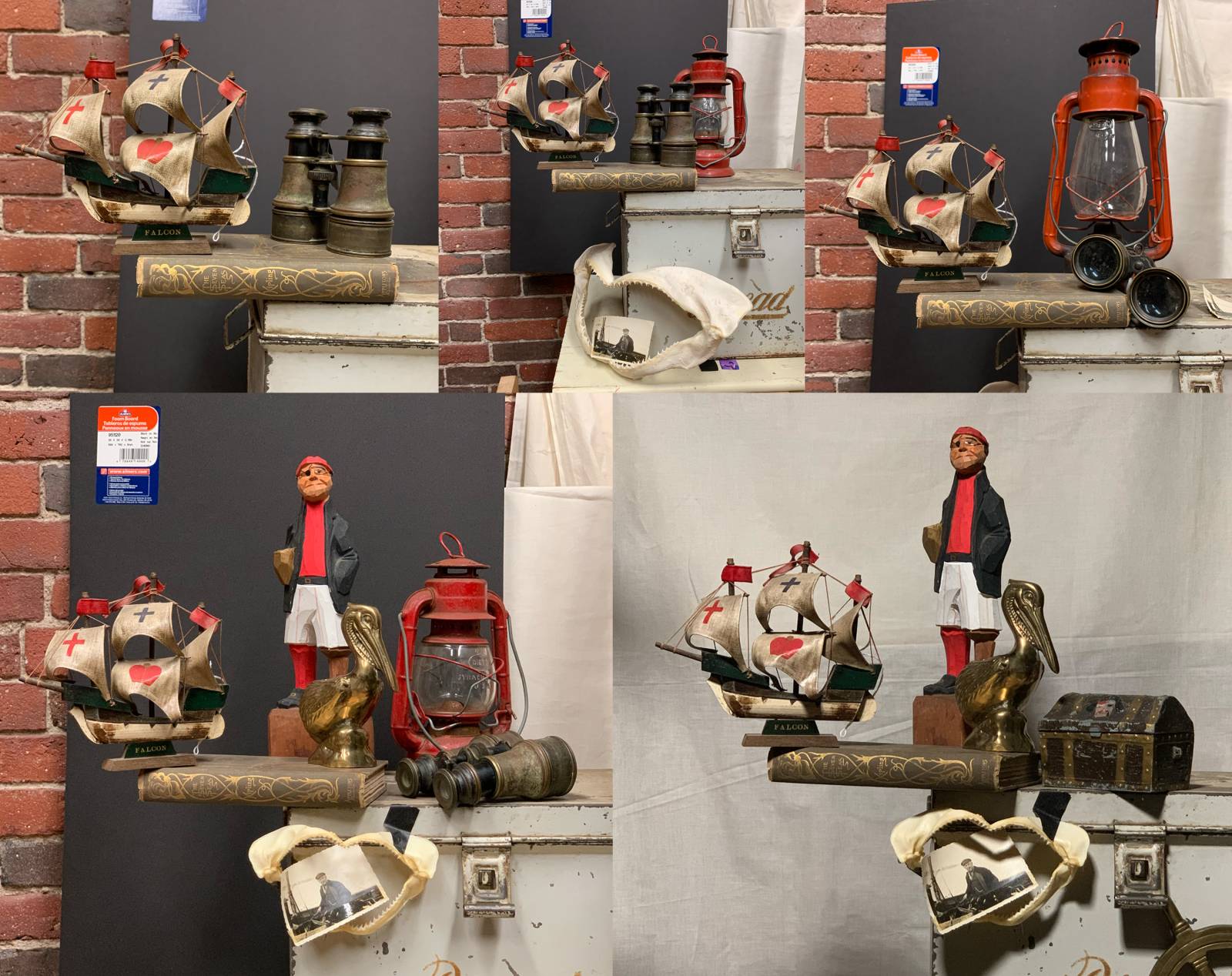
Playing with composition.
Dec 6th, 2021 – final set up
This was the final digital mock-up with the background. The background is a modification one of my favorite Winslow Homer paintings with a storm approaching and sharks in the water.

My photoshopped ref image for background.

Winslow Homer’s The Gulf Stream
Feb 13th, 2021 – The color study
A month and a half went by and 2 of those days I was able to work on the color study. This color study probably took a total of 12 hours. I use the color study to see how the real life objects and the backgrounds will relate to each other in the language of paint. The color study is used to reconcile the translation of real-world still life to oil paint and also the digital photo-bash to paint. It also let’s me know if my standard palette or “starting lineup” is sufficient or if I need any additional special guests. For this painting, my starting line up was fine.

The completed color study
Here’s a quick video of the process for this, which took 2 full days:
June 9th, 2022 – First pass of Paint Begins
You read that right, over 3 months went by before I started the actual painting. Why? I had other works in progress that were being worked on. I run an art school so I had to get the Spring term underway administratively. I was teaching an evening class. HOMEOWNER DRAMA. Wrapping up a commission. All of these things are not unusual and I’m sure you are all well aware of these distractions and time-sucks.
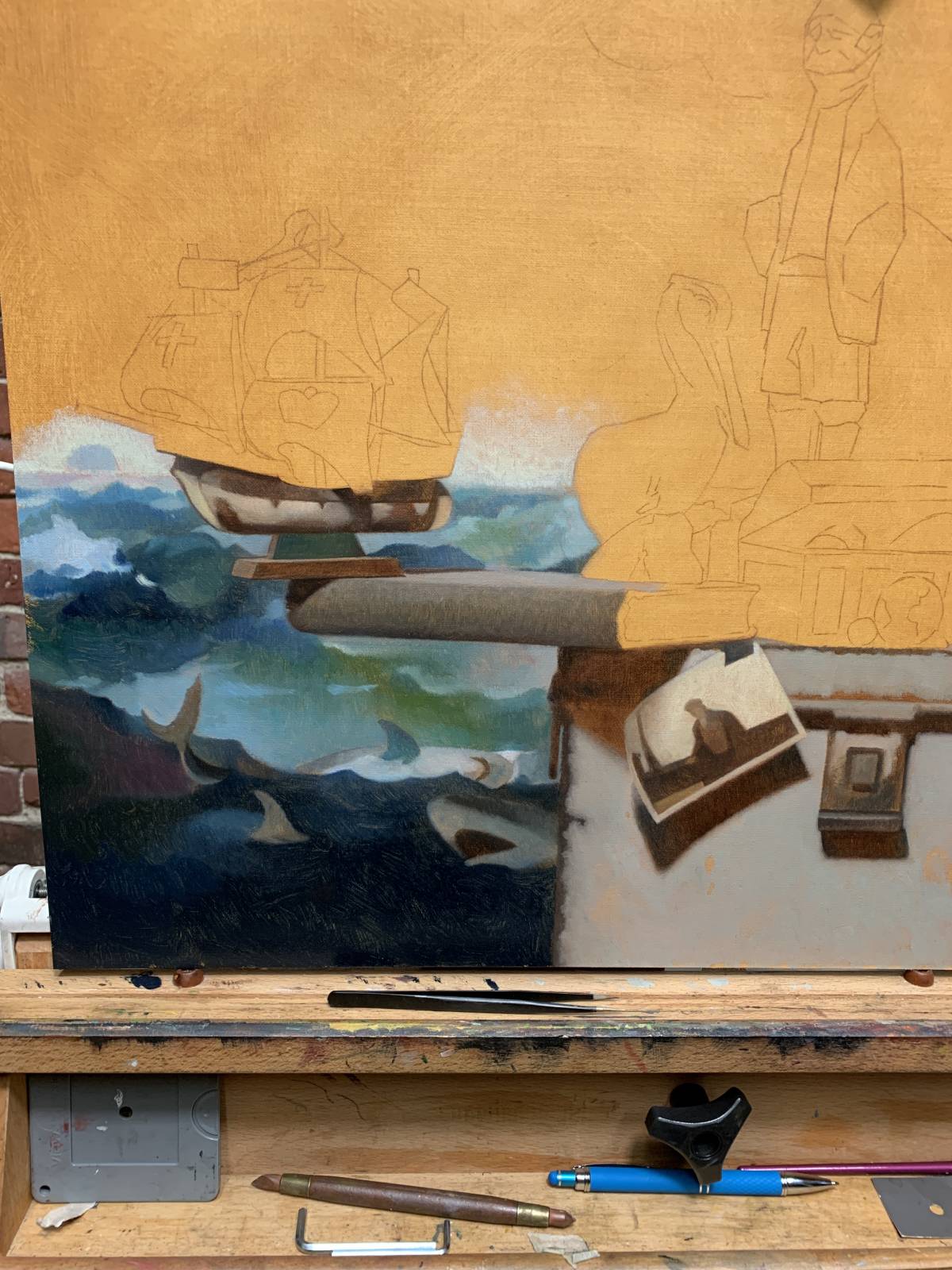
The first 9 hour session and this is what I was able to complete.
Here is a 2 and a half minute video that shows the first 19 hours of the painting in which I worked on the first pass. Not so glamorous, is it?
Tick Tock, Tick Tock
2 additional videos that show the second layer (64 hours) and the third layer (75 hours):
March 17. 2023 – Final Painting Session
Nine months and 158 hours of painting time later…. it’s done! It’s kind of like having a baby except when I’m done I can sell it and no one will judge me for it.
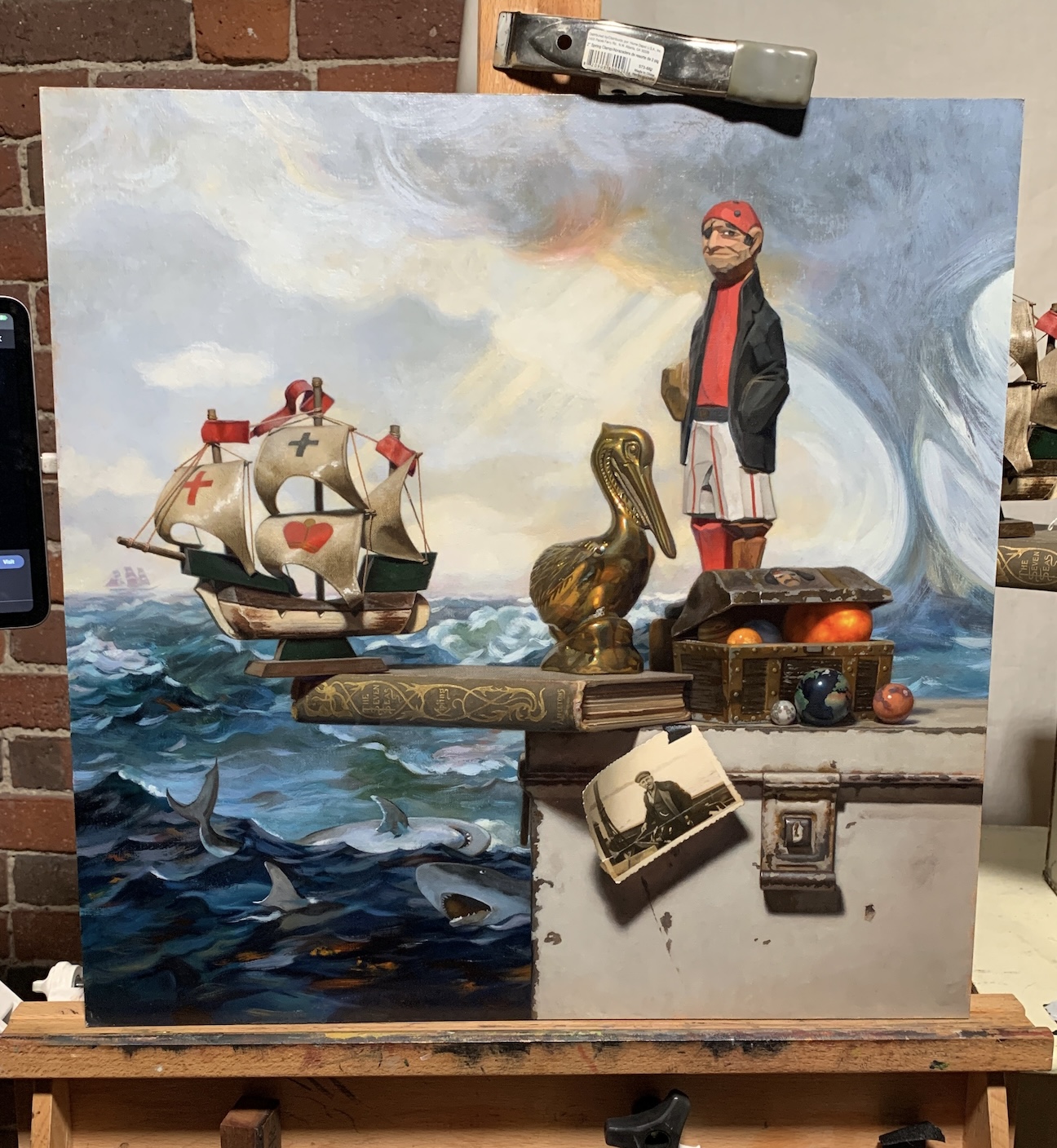
158 hours later
As you can see, a lot of effort goes into a painting of this size and complexity. 158 hours is JUST painting time. This doesn’t include the initial idea searching time, the actual set up time, if I do a preliminary drawing, the color study, or the time I spent arguing online.
In summary:
If you judged me by my online content, you’d think I can paint every day and I get a ton of work done. In reality, I paint 2 maybe 3 times a week if I’m lucky. Some years I only finish 4 or 5 major paintings. However, each of those paintings have usually 2 or 3 layers. Each day I am able to paint, I’m able to make a piece of content by simply recording parts of my process. This is the great illusion of what we see on the surface. The truth is instead of having a gloriously fun day of painting, at any given moment I’m more likely to be doing any of the following:
- procrastinating to appease the anxiety (every. single. time.) and convincing myself to just put some damn paint down
- plugging away for 9 hours on part of an underpainting
- spending the day photographing, varnishing, framing, or packaging up paintings
- collecting stuff for my monthly newsletter
- teaching or admin for the school
- spending an entire 8 hour day trying to fix 2 ellipses in a painting
- wondering why my paint is doing something I didn’t expect
- doing side studies to explore how I might use the paint differently for a certain texture
- deciding which pieces of cardboard I should keep or throw out
Toto, we are not in Kansas anymore… we’re laying on the studio floor in a pit of despair. So next time you begin to compare yourself to others and what it seems like they experience, remember that your only responsibility is to yourself (and/or the client in the case of illustration) and to make the best work you can at your own individual pace (or before the deadline). Happy painting!





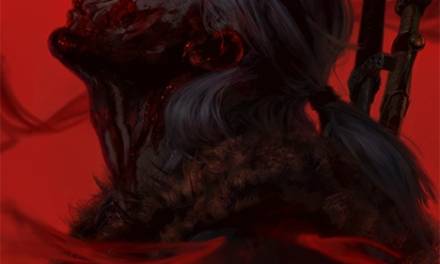


What a wonderful article! Thank you for offering this valuable knowledge. As someone who’s been painting for 10 years and is now slowing down due to my business taking too much space, I appreciate this post deeply.
Thank you for balancing reality 🙂
Thank you for your kind comment.
Instagram has been lying to me. Thank you for pulling back the curtain.
Instagram has been lying to me. Thank you for pulling back the curtain.
This was inspiring, hilarious, entertaining and enlightening and all in all one of the best articles I have read not only on muddycolors, but across art blogs and magazines over the last few years, in general. Thank you!
oh wow, thank you so much!!
Great post, Julie! Informative, funny, inspiring, and empathetic. I’m going to feel. Enter about lying on the floor now.
So comforting. Thank you for peeling back the curtain. Imposter syndrome has been kicking in and I’ve been wondering “how can do this when a painting can take over a hundred hours? I’m just too slow” But no, it just takes that much time.
Slow often means purposeful and thoughtful. Thanks!!
Seriously appreciate you posting this article, Julie. Especially with the dates associated with each step. Though I intellectually know social media is a facade built to keep us comparing, it’s hard to keep the demons quiet (during a similar anxiety-fueled floor sprawls). It’s always great to see the human creator side of the process of amazing works being made. I would love to see more of this kind of content
Glad it was helpful. I’ll meet you on the floor!
Great article, Julie! “Homeowner Drama” – tell me about it!!!!
the worst kind of drama!